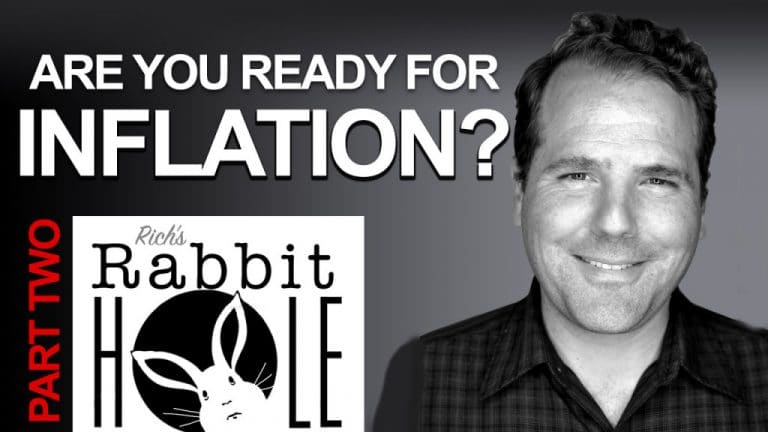Episode Two of Three of Rich’s Rabbit Hole on inflation
Utah Stories examines the likelihood of inflation as the Fed plans yet another $3 trillion spending package. Where will this all end?
Examining inflation from layman’s terms is like attempting to look at watch gears and understand how it all works. It’s not that I can begin to believe that I can understand inflation in entirety but by listening to many sources about how they describe what is happening and why things are happening the way they are, I’m beginning to feel that I have a better handle on it.
In this post I’m not going to share my thoughts that I already shared in the episode, but instead share all of my notes in researching this topic. I hope readers will do their own research and come to their own conclusions.
The basic questions we are trying to answer are the following:
- What are the causes of inflation?
- What is the government doing to mitigate inflation?
- If the government is drastically increasing the supply of money in the next few months what type of impact will that have on prices?
- Why does it appear the government has underreported inflation levels for the past ten years and what will be the consequences of the false numbers they have been reporting?
- What can we begin to expect the new economy coming out of Coronavirus look like if the economy continues to remain shut down?
So those are my basic five questions I’m attempting to answer. I will be super happy if you happen to know more than me, or you see somewhere I have gotten it wrong — please feel free to correct me.
Inflation research and show notes:
The Fed is buying municipal bonds from Cities and States:
The new program will buy up to $500 billion of short term notes — with maturities of up to two years — straight from U.S. states, counties with at least 2 million residents, and cities with a population of at least one million residents, according to the Fed release. [This will provide a capital infusion into cities and states to help keep them solvent]
How much money is in circulation?
From MarketWatch
For purists, who believe “money” refers only to physical “narrow money” (bank notes, coins, and money deposited in savings or checking accounts), the total is somewhere around $36.8 trillion. If you’re looking at “broad money,” which isn’t just physical money and includes any money held in easily accessible accounts, the number is about $90.4 trillion.
How much U.S. Currency is there outside of the United States?
From FederalReserve.gov paper on How much U.S. currency is abroad:
By Richard D. Porter
All U.S. currency, including that held externally, can be thought of as a form of interest-free Treasury borrow- ing and therefore as a savings to the taxpayer. If the amount of currency abroad is around $200 billion, and the three-month Treasury bill rate is 5.2 percent (which it is as of this writing), the amount of seigniorage (and taxpayer saving) from externally circulating currency, calculated as the product of these two figures, would be more than $10 billion per year.
U.S. currency today provides many of the monetary services that gold coins once did. As the leading international currency, Federal Reserve notes enter other national economies for reasons both public and private. Some countries, including Panama and Liberia, have elected at times to use the U.S. dollar as their currency.
Episodes of economic and political turmoil have frequently been the catalyst for major influxes of dollars into a region. Recently, Argentina and the former Soviet Union received large inflows of dollars. In Argentina, which experienced chronic high inflation from the 1960s to the early 1990s and brief bouts of hyperinflation in the mid 1970s and late 1980s, U.S. currency is still used as the settlement medium for large-scale transactions such as those involving real estate and cars.3 Argentina has received as much as $40 billion in net shipments of U.S. currency, or well over $1,000 per capita.
Overall, the shipments data indicate that well over $100 billion in U.S. currency on net has moved overseas since the late 1980s. {this is only through 1990}
Net U.S. currency flows to Russia alone in both 1994 and 1995 have been at least $20 billion per year, or well more than half of total net foreign shipments of U.S. currency.
According to the Federal Reserve, there are currently $1.74 trillion paper dollars in circulation. How many of these notes circulate in the U.S. and how many are used overseas?
Because banknotes cannot be tracked, this question is particularly difficult to answer. This blog post explores several approaches for determining the location of notes. These approaches offer a wide range of estimates, from as low as 40% of all currency being held outside of U.S. borders to as high as 72%.
What does the Bureau of Labor Statistics say about the reasoning behind why they keep altering the way they measure inflation?
As can be seen from the path of the change in the All-Items CPI, shown in figure 5, the period from 1968 to 1983 stands out as the definitive era of sustained inflation in the 20th-century United States. The period spanned the boom-time inflation of the late 1960s, the frustrating stagflation of much of the 1970s, and the double-digit inflation of the early 1980s. More than ever before, inflation was the most pressing economic concern of the public and policymakers, and it proved to be an issue that dominated elections.
By this period, the composition of the American market basket, and thus the composition of the market basket used to calculate the CPI, had become much closer to that of the current era. The relative importance of food in the index continued to decline: in 1968 it was over 22 percent, while by the early 1980s it was under 20 percent. Notably, in 1978 the CPI published a new measure, the Consumer Price Index for All Urban Consumers (CPI-U), based on the spending patterns of a broader subset of the population.
Inflation steadily worsened during the Carter era: prices rose nearly 7 percent in 1977 and 9 percent in 1978. By this time, inflation seemed to have momentum, and it was recognized that inflationary expectations could generate inflation. As President Carter put it,47
In the last 10 years, in our attempts to protect ourselves from inflation, we’ve developed attitudes and habits that actually keep inflation going once it has begun. Most companies raise their prices because they expect costs to rise. Unions call for large wage settlements because they expect it to happen, and once it’s started, wages and prices chase each other up and up. It’s like a crowd standing at a football stadium. No one can see any better than when everyone is sitting down, but no one is willing to be the first to sit down.
The Carter administration steadfastly sought to reverse the acceleration. Though not resorting to Nixon-style mandatory wage and price controls, President Carter advocated (1) voluntary controls backed by various government sanctions and incentives, (2) reducing the inflationary effects of fiscal policy through deficit reduction, and (3) deregulation to increase competition and limit price increases.48 Any success these measures had, however, was extinguished by a fresh burst of energy inflation in 1979, pushing the 12-month increase in the All-Items CPI over 13 percent by the end of 1979.
Inflation finally started to abate in 1981 and fell sharply in 1982. The reverberations of the energy supply shock quieted, and a Federal Reserve Board determined to rein inflation in pursued a tighter monetary policy. The result was a plunging CPI but a soaring unemployment rate; the era of high inflation ended, but left in its wake a bitter recession. Fortunately, the economy would recover, and 1983 would mark the end of a frustrating era that combined high inflation with substantial unemployment and sluggish growth.
Conclusion on BLS explanation:
They are obfuscating the issue by being confusing and giving an overly long and complicated explanation.
Why Does the Fed give more credence to the CPI than the PCE or other indexes?
Benchmark that the Fed pays more attention to than the CPI (consumer Price Index) is the PCE (Personal Consumption Expenditure). Why?
Reuters (in Feb 2018) made a case that inflation was about to occur which would make the Fed likely to raise interest rates to dampen the overheated economy. This was due to a near zero employment rate.
The monthly CPI, compiled by the Labor Department’s Bureau of Labor Statistics (BLS), measures the change in prices paid by consumers for goods and services. The BLS data is based on spending patterns of consumers and wage earners, although it excludes rural residents and members of the Armed Forces.
CPI measures the prices that consumers pay for frequently purchased items. The components are weighted to reflect their relative importance, with the weightings derived from household surveys. Some of the components of the CPI basket such as food and energy can be volatile. Stripping out food and energy from the CPI gives us the core CPI, seen as a measure of the underlying inflation trend.
The January reading on consumer prices released on Wednesday showed prices rose more than expected, up 0.5 percent versus the 0.3 percent expectation. The core reading rose 0.3 percent against the 0.2 percent forecast. Both numbers increased from the 0.2 percent reading for December.
WHAT SPARKED THE RECENT INFLATION WORRY?
The government’s monthly employment report for January, released on Feb. 2, showed wages posted their largest annual gain in more than 8-1/2 years, suggesting the economy was moving closer to full employment and inflation was on the horizon.
Milton Freedman Speaking on Inflation: Taxation without representation
Let’s listen to the great Milton Freedman talk about our national debt and how our government uses inflation as a tool to earn more money. This clip comes from a documentary film I can highly recommend that Freedman made back in 1980, not long after the U.S. had experienced some of its worst inflation in decades.
https://youtu.be/GJ4TTNeSUdQ (7:15)
So Milton Freedman calls it “Taxation without representation” because you are paying more for everything, every year and even if your wages go up, the government can then justify themselves getting more because you are earning more. But if the money today doesn’t buy what it bought a year ago, you are actually earning less and paying more in taxes.
The Political Benefits of Artificially Low Inflation
Freedman also spoke about how inflation works, especially in terms of how the government can use it as a tool to be able to promise all sorts of things like stimulus spending, tax cuts, massive government programs. When the truth is that inflation can be the greatest friend of political leaders because it’s actually a hidden tax. If political leaders keep inflation low (when it’s actually much higher), this is essentially a hidden tax in two instances. First as money loses it’s value to the degree they claim it does 2%-3% per year. This also amounts to an equal decline in the amount of actual debt that the United States maintains on it’s balance sheet. Second, if money is losing it’s value to more than twice the pace that they are reporting (as many economists agree the actual rate of inflation stands at 5-6%), then this amounts to billions of dollars in fewer government expenditures pay out benefits to Social Security, military, and welfare recipients. So, in some ways on the political end of things, this is a win-win. No need to increase benefits to welfare recipients because they are inflating the value of our currency away.
However, this is a big loss to the American people at large because it is essentially, as Milton Freedman describes, “taxation without representation.” or a hidden tax on wealth.
The Case That the U.S. Won’t Suffer Inflation Because we are the Reserve Currency
There is currently a shortage of U.S. dollars and they want to get more of our dollars because their currencies are weak and they actually use U.S. dollars as their reserve currency. The Euro, Yen and U.S. dollars are the top currencies, and 61% of the world uses U.S. dollars as reserve currencies. Does that mean we are set because we can count on the supply of dollars or treasuries being eaten up by foreign nations?
I actually don’t know the answer to this question but Mohamed El-Erian, Chief Economic Advisor to the financial services company, Allianz was on the Ben Shapiro show and he talked about this and described the United States and our fiscal policy like this:
“We are the cleanest dirty shirts”. All other nations have dirty shirts, in terms of their currencies and their fiscal policies, we are the cleanest of the dirty shirts.
What I believe he means by this is that when we compare the position the United States is in with most other nations we have a much better ratio in terms of debt to GDP (Gross Domestic Product, than other nations. The U.S. has a massive GDP. California alone has a a massive GDP. So our political leaders keep saying that our debt doesn’t really matter because when we examine it in terms of our overall GDP it’s not as bad as other nations.
Okay, so should we worry about inflation? If other nations are gobbling up our treasuries and they want our U.S. dollars can’t we just continue printing money and issuing treasuries to create that value?
We don’t really know the end game or the answer here because there has never been another nation with such a high GDP and decent GDP to debt ration that has printed and spend so much money so quickly on a massive scale.
But according to the Bureau of Labor Statistics, our inflation rate is incredibly consistant. We haven’t seen any major increases in inflation since the 1970s
[find chart]
Really? So the cost of housing, of cars and even things like coffee haven’t really gone up?
Okay, I’m going to warn you here: I’m going to get into the weeds of how our government calculates inflation. What I can tell you in simple terms is that they keep changing the measuring stick.
The major change they made to the way they calculate inflation is the Consumer Price Index. This is basically a measure of consumption that has very little to do with the actual inflation we are experiencing. The Bureau of Labor Statistics provides the Consumer Price Index Calculation to the Fed, which in turn determines what is known as the prime interest rate. It’s this rate that is used to allow the Fed to loan money to banks. And it’s the prime rate that determines how expensive or cheap borrowing money is.
The Fed determines our monetary policy. Lets consider that in greater detail. An independent government agency known as the Federal Reserve Bank, determines and set policies for how much money is printed and what the interest rate is for lending banks money. I’ll show you their goals right off their website:
Each year, the FOMC {Fed} explains in a public statement how it interprets its monetary policy goals and the principles that guide its strategy for achieving them.3 The FOMC judges that low and stable inflation at the rate of 2 percent per year, as measured by the annual change in the price index for personal consumption expenditures etc.
I’ll leave the link to this page in the shownotes. I suggest you go check it out.
But what they are saying here, is the need the inflation rate to remain at a stable 2% rate, that is their goal. And they measure consumer spending to determine if they have achieved that goal. But what I’m saying is rather than make the measurement consistent over the years, they are changing the way they measure so that they can reach 2%.
Now you are probably scratching your head. Why would they do this?
Because it’s way easier for them to say we are maintaining a consistant 2% a year inflation rate than to say that inflation is increasing. And they are basically telling the government (who they work for), what they want to hear. And what we want to hear.
They are doing everything they can to keep their jobs. Just as politicians are doing everything they can to keep their jobs by not raising taxes. And when everyone is just doing everything that they can to keep their jobs and make us happy so they can stay in office then we get the environment we are living in today, where:
- the gap between the rich and the poor is widening,
- the amount we are paying in taxes is increasing
- social security payouts in real terms is declining
- The cost of goods (especially for decent quality goods) is increasing
How does this happen?
Well look at this. If we are essentially ignoring inflation, especially in terms of actual wage growth along with inflation growth, then while the reality is that people are not able to buy for the same money what they could a year ago, but the government says inflation was just 2%, then employers can justify not paying employees more than the inflation rate.
The same goes for social security payouts. The amount of increase in SS payments is determined by the inflation rate. Benefits for veterans is tied to inflation, so are pensions. So the gap between the rich, who have more real wealth and assets; and the poor, many of which live paycheck to paycheck — is in reality widening because our government is doing exactly what we want: they are keeping interest rates low; they are keeping spending high; We are going further and further into debt, which economists tell us not to worry about because U.S. dollars are the reserve currency, and as they say, “it is what it is.”
I’m going to leave this episode at that. What I’m leaving out right now is what you can do about it, and what the very top minds and economists are saying regarding ongoing inflation concerns especially with the Fed and Congress just spending an additional $6 trillion. How will this impact inflation?
I actually originally set out to answer those questions, but this is going to have to be a multi-part series because I realize when I’m talking technical terms I need to keep it to a minimum.
So if you like this content, please share it with a few friends. Really, that is the only meathod we are counting on to grow this program and our audience. Facebook is not a platform that I wish to rely upon or use, which I’ve explained in previous episodes, so please, if you enjoyed this share it with your friends and subscribe to us on iTunes or YouTube, and subscribe to our Utah Stories newsletter.
Addendum:
What can we expect in the coming year as related to inflation?
Transcript of interview between Ben Shapiro and Mohamed El-Erian, Chief Economic Advisor to the financial services company, Allianz
(1:01:21) Are we entering into a situation where the United States will have to either radically raise taxes or we will need to radically inflate the currency?
“There are three issues here:
El-Erian:First the inflation risk: yes it is going up. The days when we didn’t need to worry about inflation because inflation was too low: that has gone away. We are going to have high inflation coming out of this. That is part of winning the peace. And why? Because when we restart the economy, you and I will want to buy things much faster than they will be made available. Demand is going to recover before supply does
Second issue: No, we are not going to have problems selling the debt. I call it the “cleanest dirty shirt.”… We are the cleanest dirty shirt by far. We will be able to sell our debt. We are the reserve currency.
Third issue: We are going to come out of this will a very deep government, and private sector entanglement. It will be a spaghetti bowl. You and I are going to come out of this. Because all of this is happening ad-hockly — the deep entanglement of government with private interests, that will bring down our growth potential.
Lets take bailouts: we have already identified Boeing and the airlines who will need bailouts. Every single sector that is having a simultaneous problem of production and consumption. So the bailout line is going to be very, very long. So when you don’t have clear terms for:
- Who you are going to bail out?
- On what terms?
- For how long?
You are going to end up with a spaghetti bowl. What is the spaghetti bowl? So Boeing survives thanks to the government’s help, so what is the government’s claim on Boeing when they recover? How long should the government be an equity holder in Boeing?
Was this an Avoidable Mistake? Did the use of central banks as chief policy makers, not only in the United States but all over the world lead up to a lot of our inability to deal with this problem? and does it inhibit our recovery on the other end?
El-Erian: Yes, and yes. This was an avoidable mistake. I wrote a book called an Avoidable Mistake. The path we were on, relying only on Central Banks would lead to the path of its own destruction. I argued that the vulnerability to a shark would lead to a recession. Our ability to recover will be less strong because of this. We didn’t win the peace from the last financial recovery we won the war.
How do we prepare? What will be the permanent landscape shifts? What does the post crisis landscape look like?
El-Erian: We are going to look very different. If you are a company you are going to shift from efficiency to resilience. We are going to de-globalize the world. Households are going to change to resilience. Institutions are going to come out of this battered. Our ability to afford debt will be lessened. Central Banks are going to have massive balance sheets that we need to deal with.
In less than two weeks we have over a trillion and four trillion is in the cards. The aftermath of the crisis is going to be as bad as the crisis we have now.
Will Producers Leave China?
El-Erian: The last thing that we want for our kids is that a company is international when it makes profits and national when things go bad and it needs to be bailed out. We need to stop this.
How Far Will The Stock Market drop? Is this a buying opportunity?
El-Erian: I don’t think it has gone all the way. We are just about understanding the severity of this shock. We don’t understand in the marketplace how long it will take the measures to work. It’s not about pressing a reset button. Expect volatility around a declining trend right now. In volatility you are likely going to make a mistake. What mistake are you going to make? Regret minimization should lead investment policy. It’s better to be too late back into the market than too early.
EU breaking up? Rioting? Social Unrest? When is it going to be to the point where we need to get people back to work?
El-Erian: Being risk averse doesn’t mean taking any risk. It means taking calculated risk. If we were complertely risk averse we wouldn’t even cross the street. It’s going to be once we have gotten control, when we understand how this virus spreads. And when we can treat the ill better, when we have ventilators. If we shut down the economy for one to two years, it’s going to be worse than the virus. We aren’t there yet, we have time.







